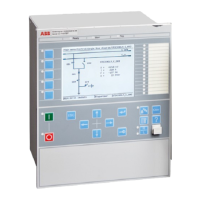method and with no circulation (for example, assume two equal transformers on the same tap
position). The load current lags the busbar voltage U
B
with the power factor j and the
argument of the impedance
Rline
and
Xline
is designated j1.
U
B
jI
T
*Xline
U
L
Xline
Rline
Zline
I
T
I
T
*Rline
j
j
1
j
2
DU
en06000626.vsd
IEC06000626 V1 EN-US
Figure 162: Transformer with reverse reactance regulation and no circulating current
The voltage DU=U
B
-U
L
=I
T
*
Rline
+j I
T
*
Xline
has the argument j2 and it is realised that if j2 is
slightly less than -90°, then U
L
will have approximately the same length as U
B
regardless of the
magnitude of the transformer load current I
T
(indicated with the dashed line). The automatic
tap change control regulates the voltage towards a set target value, representing a voltage
magnitude, without considering the phase angle. Thus, U
B
as well as U
L
and also the dashed
line could all be said to be on the target value.
Assume that we want to achieve that j
2
= -90°, then:
0
1 1
( )
90
0
1
0
1
90
90
j j
j j
U Z I
Ue Ze Ie ZIe
j j j
j
j j
j j
+
-
D = ´
ß
D = ´ =
ß
- = +
ß
= - -
EQUATION1938 V1 EN-US (Equation 127)
If for example cosj = 0.8 then j = arcos 0.8 = 37°. With the references in figure 162, j will be
negative (inductive load) and we get:
0 0 0
1
( 37 ) 90 53
j
= - - - = -
EQUATION1939 V1 EN-US (Equation 128)
To achieve a more correct regulation, an adjustment to a value of j2 slightly less than -90° (2 –
4° less) can be made.
1MRK 511 358-UEN A Section 13
Control
327
Application manual

